Queensland’s rental market remains stuck in gridlock, with the latest REIQ September Quarter 2025 Residential Vacancy Rate Report showing the statewide vacancy rate frozen at just 1.0%. That’s well below the healthy benchmark of 2.6%–3.5%, and it’s keeping people firmly locked in place!
Across the state, 38 of the 50 regions are sitting at or below 1.0%, proving just how tough it is for renters to find their next home. While some pockets shifted slightly this quarter, the overall market remains incredibly tight, creating a statewide traffic jam of tenants wanting to move—but unable to find anywhere to go.
A Market Stuck in Gridlock
REIQ CEO Antonia Mercorella says Queensland’s rental market is behaving exactly like a peak-hour motorway. People are staying put not because they want to, but because the competition for listings is so fierce.
Many renters are renewing leases out of necessity rather than choice—often applying for multiple properties at once just to secure one. Property managers are still receiving a flood of applications for each listing, but many of these are simply “backup plans”.
Tenancy lengths are creeping up too. New RTA data shows:
-
Houses: Median tenancy up to 21.1 months
-
Units: Holding steady at 18.2 months
Longer leases might sound like a positive, but in this climate it signals limited choice rather rather than genuine tenant stability.
Owner Sentiment Shifting
The report also reveals growing frustration from rental property owners. With rising costs, stricter legislation, and a spike in early break leases (due to new limits on tenant liability), many owners are feeling the pressure.
A growing number of tenants are accepting lease terms they don’t intend to keep—continuing their search for something better even after moving in. These early breaks leave many owners footing new advertising and reletting costs, with little rent compensation.
Bundaberg’s Vacancy Rate
Bundaberg’s rental market mirrors the broader Queensland squeeze, recording a very tight 1.0% vacancy rate this quarter. This places Bundaberg firmly in the “tight” category, highlighting strong tenant demand, limited supply, and fast-moving rental conditions across the region. Local property managers continue to see high application volumes and quick leasing turnarounds, with few signs of easing in the months ahead.
Not All Markets Are Equal
Although Queensland is deep in a rental crisis, not every pocket of the state feels the same.
Higher-end properties, older or lower-quality homes, or niche market segments can still linger on the market, especially if they’re overpriced. Even in a tight market, tenants remain price-sensitive.
Looking Ahead: More Tight Conditions on the Way
Don’t expect relief anytime soon. The REIQ says rental activity is now steady year-round, with the usual seasonal peaks flattening out completely.
The main issue hasn’t changed—Queensland’s housing supply simply isn’t meeting demand. The call to action is clear:
-
More new builds
-
More private rental sector investment
-
Support for build-to-rent and diverse housing formats
-
Fair legislation that encourages investors to stay in the market
Until housing supply gets moving, the rental gridlock will continue.
Queensland’s Tightest and Weakest Markets
At the extreme end, some regions have virtually no vacancies:
-
0.0% — Cook
-
0.1% — Charters Towers, Goondiwindi
-
0.2% – 0.3% — Banana, Maranoa
Major population hubs are also squeezed:
-
Greater Brisbane: 0.9%
-
Brisbane LGA: 1.1%
-
Ipswich & Logan: 0.8%
-
Redland & Sunshine Coast: 1.0%
-
Toowoomba: 0.5%
-
Cairns: 0.7%
-
Townsville & Rockhampton: 0.8%
-
Mackay: 0.9%
A few areas show signs of relief:
-
Noosa: 1.9%
-
Gladstone: 2.2%
-
Bay Islands: 4.0%
-
Isaac: 5.5%
These last two are Queensland’s only “weak” markets.
Quarterly Movements Worth Noting
Some of the biggest drops were seen on the Sunshine Coast:
-
Maroochy Coast: –0.5pp
-
Hinterland: –0.5pp
-
Noosa: –0.5pp
Other regions slipped by –0.3pp, including Banana, Cassowary Coast, and Central Highlands.
Fifteen regions held steady this quarter, including Greater Brisbane, Ipswich, Logan, Redcliffe, Toowoomba and Cook.
Modest increases of +0.1pp were seen in Brisbane, Moreton Bay, Redland, Bundaberg, Mackay, Rockhampton, Livingstone and Southern Downs.
Gladstone experienced a larger rise of +0.4pp, while Bay Islands lifted +0.3pp, and Isaac jumped by +1.3pp.
Fast Facts – September Quarter 2025
-
Statewide vacancy rate: 1.0%
-
Bundaberg vacancy rate: 1.0%
-
Tightest markets: Cook (0.0%), Charters Towers (0.1%), Goondiwindi (0.1%)
-
Highest vacancy rates: Isaac (5.5%), Bay Islands (4.0%), Noosa (1.9%)
-
Largest drops: –0.5pp in Maroochy Coast, Hinterland & Noosa
-
Largest rises: +1.3pp Isaac, +0.4pp Gladstone, +0.3pp Bay Islands
-
Market categories:
-
0–2.5% = Tight
-
2.6–3.5% = Healthy
-
3.6%+ = Weak
-




